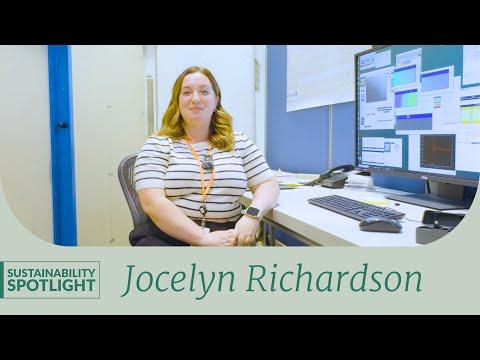Spotlight on sustainability research: Jocelyn Richardson on supporting ecosystem health
An associate scientist at SSRL, Richardson studies plant growth to find ways to enhance nutrient uptake in plants, especially in challenging conditions – such as higher temperatures, drought, and intense precipitation events – brought about by climate change.
This series explores how early-career researchers are helping the DOE's SLAC National Accelerator Laboratory and Stanford University reimagine our energy future. United around the goal of sustainability, these scientists and engineers have embarked on paths that target specific solutions, such as better batteries, alternative energy sources and a stronger electric grid. Their efforts fuel the SLAC-Stanford sustainability ecosystem where bright ideas meet powerful tools for scientific investigation.

Jocelyn Richardson
SLAC associate scientist, Stanford Synchrotron Radiation Lightsource (SSRL)
PhD in Earth and Planetary Science, 2019
Exploring plant growth
My research focuses on understanding how plants and their associated soil microbes uptake nutrients and heavy metals from soil. This knowledge aims to inform sustainable ways of increasing nutrient availability to plants without relying on fertilizers.
Plants, like us, need specific nutrients to thrive. They obtain these nutrients from the soil, where their roots facilitate uptake. Nutrients such as phosphorus, sulfur, potassium, and essential metals like iron and manganese are present in soil, though often bound within soil minerals in forms not directly accessible to plants or microbes.
Various soil processes must take place to make these nutrients bioavailable to plants. I study these processes, examining how nutrients transition from unavailable to bioavailable forms. By better understanding these mechanisms, we can explore ways to enhance nutrient uptake in plants, especially in challenging conditions brought about by climate change, such as higher temperatures, drought, and intense precipitation events.

The SLAC-Stanford connection
The Stanford Synchrotron Radiation Lightsource (SSRL) at SLAC is essential for my research. Here, we use specialized X-ray techniques to visualize nutrients of interest in situ, without needing to alter the samples. This allows us to image specific nutrients within different plant structures – leaves, stems, and even intact soil cores – directly in the lab and observe their natural distribution.
In the future, we plan to acquire a plant growth chamber at SSRL, which will allow us to conduct dynamic studies on nutrient uptake. We can grow plants in the chamber, take them to the beamline for in situ nutrient measurements, then return them to the chamber for further growth. This process allows us to observe nutrient uptake over time, a unique capability not commonly available at other synchrotron facilities.

Advancing toward sustainable solutions for global plant growth and ecosystem health
The inspiration
At SSRL, our work is supported by a facilities grant from the Department of Energy's Biological and Environmental Research Division, which encourages research within their mission area. Since I started five years ago, my role has included fostering this type of research with collaborators, focusing on plants, beneficial soil microbes, and soil interactions. This collaboration has also shaped my personal research focus, particularly on potassium uptake by plants.
What drives me in this work is a love for learning. Every day in the lab, I discover something new, whether studying a different plant or a novel microbe. Each dataset brings new insights, helping us advance toward a more sustainable understanding and approach to supporting plant growth and ecosystem health worldwide.
SSRL is a DOE Office of Science user facility.
For questions or comments, contact SLAC Strategic Communications & External Affairs at communications@slac.stanford.edu.
About SLAC
SLAC National Accelerator Laboratory explores how the universe works at the biggest, smallest and fastest scales and invents powerful tools used by researchers around the globe. As world leaders in ultrafast science and bold explorers of the physics of the universe, we forge new ground in understanding our origins and building a healthier and more sustainable future. Our discovery and innovation help develop new materials and chemical processes and open unprecedented views of the cosmos and life’s most delicate machinery. Building on more than 60 years of visionary research, we help shape the future by advancing areas such as quantum technology, scientific computing and the development of next-generation accelerators.
SLAC is operated by Stanford University for the U.S. Department of Energy’s Office of Science. The Office of Science is the single largest supporter of basic research in the physical sciences in the United States and is working to address some of the most pressing challenges of our time.





